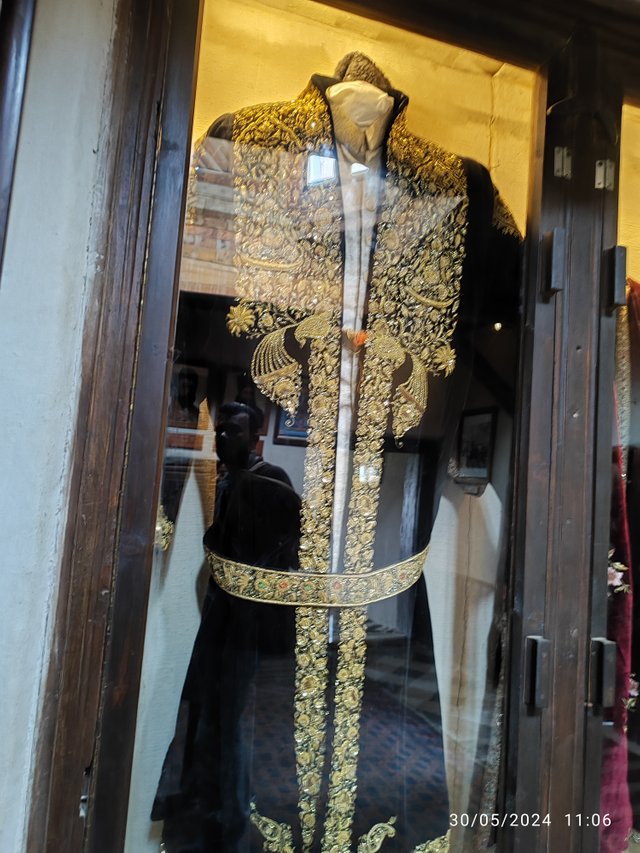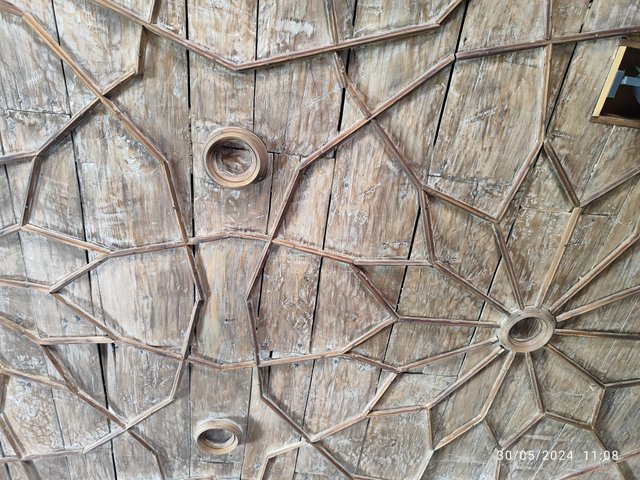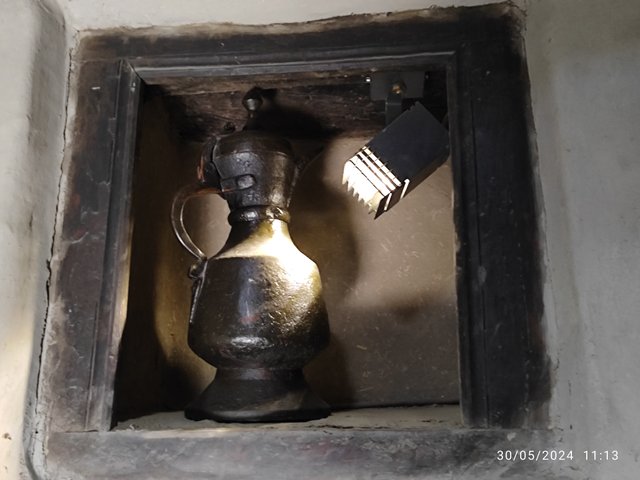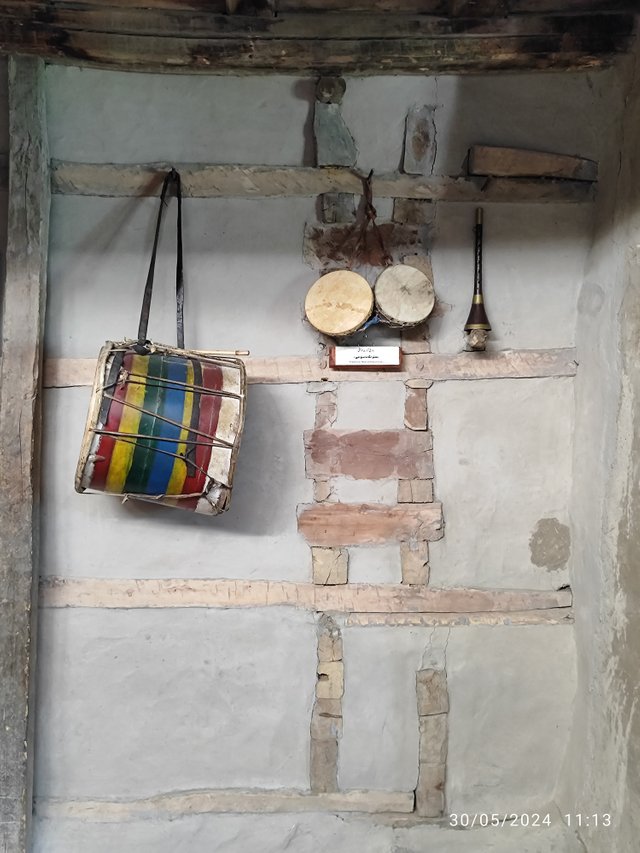Baltit Fort Karimabad: May 30th (part II)

The Aga Khan Trust for Culture has restored the prime historic landmark of the 700 year old Baltit Fort on the terraced slopes in Hunza, in Northern Pakistan. The main theme of the project is to preserve this setting despite natural decay and the inevitable impact of recent changes, such as urbanisation which has begun to threaten the integrity of the built heritage. The Fort is now a museum and cultural centre. Moreover, culturally and environmentally compatible small enterprises are being promoted which provide gift items, local woollen rugs and hand-knotted vegetable dye carpets for visitors.
Source: Aga Khan Trust for Culture
Can you spot our tour guide in the following picture :)

I love this picture. Couldn't be more filmy ;)))
In the previous post about Baltit Fort I gave you a detailed tour of first floor, now we are heading towards the top floor. The upper floor has a courtyard with stunning views of the valley.

A door on the upper portion leads to the fort’s backyard. The British demolished the watchtower that once stood here.
From the backyard, visitors can see Mir’s water channel and the Ultar glacier.




Coloured glass windows in the bedroom offer a view of the valley.

 |  |
|---|
A beautifully crafted wooden throne and wooden ceiling are present in the courtyard. This space is where the leader of Hunza, known as the Mir, would meet villagers and hold events.
Within this floor of the fort, there is a fascinating pictorial library showcasing historical photographs of the Mir (king) of Hunza, the princess, and other prominent figures who lived in the region. These images offer a glimpse into the royal family and key individuals who played a significant role in the area's history, providing a deeper understanding of the cultural and social dynamics of Hunza over time. The collection serves as both a historical archive and a visual journey through the lives of the people who shaped the region. Let's take a look:
 |  |
|---|
 |  |
|---|
 |  |
|---|
 |  |
|---|
This interesting document caught my attention. Upon asking the guide, I learned that it was an archive of trade documents.

Historic trade agreements between China and Baltistan.
The following pictures display the intricate craftsmanship and cultural heritage preserved in Baltit Fort. They feature beautifully carved wooden ceilings, traditional furniture, handwoven carpets, and shelves adorned with pottery and metal artifacts. The door to the Mir’s bedroom has detailed carvings, and the room includes a golden carpet and historical agreements displayed on the walls. The images also showcase framed documents, traditional seating areas, and decorative woodwork, reflecting the royal lifestyle and architectural elegance of the fort:

A carved skylight in the ceiling provides natural light.


This carpet was made in Khutan (China), some 300 years ago.
There was a trend amongst the prominent families of Hunza of bringing carpets from China or purchasing them from the trade caravans that moved along the Silk Route, and they were not manufactured in the area till the late 1990s. sr
 |  |
|---|
 |  |
|---|
 |  |
|---|
The room with cushions on the floor and low tables may represent a traditional sitting room or a space where the Mir (leader) and his family conducted informal meetings or discussions. The reception rooms contain pictures of the royal family, weapons, and Ibex heads.


 |  |
|---|

Baltit Fort houses a variety of traditional musical instruments that reflect the rich cultural heritage of the region. Some of these instruments include Dadang (Drum), Surnai, and Daf as I have captured on the wall
These instruments were historically used for various purposes, including celebrations, religious events, and during gatherings held at the fort by the Mir (ruler) of Hunza.

This ⬆️ image shows a collection of old Chinese paper currency from the years 1930-1931, framed and displayed at Baltit Fort. This exhibit highlights the historical connection between the Hunza region and China, particularly through trade and cultural exchanges.

Upon descending from the fort's rooftop, we observed a stone-paved terrace with a historical cannon on display, showcasing the fort’s defensive past. Modern solar panels were visible, reflecting efforts to incorporate renewable energy while preserving the historical structure. The buildings, constructed with traditional stone masonry characteristic of the Hunza region, seamlessly blended into the natural landscape. The lush greenery of the valley and distant mountains highlighted the fort’s elevated and strategic location, offering panoramic views of the region.



Hunza State victoriously test fired this cannon in 1869

That brings us to the end of my journey through the enchanting Baltit Fort. I know I promised to show you my jewellery shopping, but it seems I’ve run out of space for this travelogue. Not to worry, I’ll share them in my next one, where I’ll also take you along to explore the stunning Naltar Valley. Stay tuned for more!
All photos featured in this travelogue are taken by me using my personal camera and are my property. They may not be used or reproduced without my explicit permission.
... she reminds me of someone... ;)
Hahaha
The eyes;)))
🤣 😂😅
This are really beautiful artifacts your country have preserved for decades…
Why was the “watchtower” destroyed… was it blocking the view to the Mir’s water channel and the Ultar glacier?
The British destroyed it apparently...
Thanks for stopping by! I have put my heart and soul into these travelogues. It makes ne happy when people read them :)
You are welcome ma..
Hi
Can we talk on discord?
I don’t have the app yet…
When I get to work tomorrow morning, I’ll download it and let you know!! Is sleeping time in Nigeria
I’ve opened my discord account and my username is sbamson4511
Those are some stunning pictures and the place is so beautiful ❤️
I'm glad you liked it.
Thank you for stopping by!
welcome
Thank you, friend!


I'm @steem.history, who is steem witness.
Thank you for witnessvoting for me.
please click it!
(Go to https://steemit.com/~witnesses and type fbslo at the bottom of the page)
The weight is reduced because of the lack of Voting Power. If you vote for me as a witness, you can get my little vote.
Your post is manually rewarded by the
World of Xpilar Community Curation Trail
BottoSTEEM OPERATED AND MAINTAINED BY XPILAR TEAM
BottoSteem
Robust Automations on STEEM Blockchain using the Power of AI
https://steemit.com/~witnesses vote xpilar.witness
"Become successful with @wox-helpfund!"
If you want to know more click on the link
https://steemit.com/@wox-helpfund ❤️
🌄 "Wow, what an incredible journey through the Baltit Fort! 🏰 The stunning images you've shared are truly breathtaking, showcasing the rich cultural heritage and historical significance of this enchanting place. I'm especially fascinated by the traditional musical instruments and the historical connection with China, as well as the exhibit on the Hunza region's past.
Your travelogue is not only visually appealing but also engaging and informative, making me feel like I'm right there with you, exploring the fort's nooks and crannies. I love how you've captured the blend of tradition and modernity, from the stone-paved terraces to the solar panels and the cannon on display.
I'm so looking forward to your next travelogue, where you'll take us to explore the stunning Naltar Valley! Keep sharing your adventures and inspiring us with your photography. 📸🌟
Also, I just want to remind everyone that we have an amazing witness in 'xpilar.witness' who deserves our support. If you haven't already, please head over to https://steemitwallet.com/~witnesses and vote for them. Let's help grow and strengthen our community together! 💚"
I'm already supporting xpilar.witness
Thanks for stopping by
It was wonderful to see the 700-year-old Baltit Fort, a true gem of Hunza, being given a new lease of life. This renovation not only preserves its historical significance but adapts it for modern cultural activities as a museum and cultural center. The integration of local enterprises selling traditional crafts is a wonderful touch and enriches the visitor experience while supporting local artisans. The detailed tour upstairs of the fort is impressive, offering panoramic views and a glimpse of its storied past.